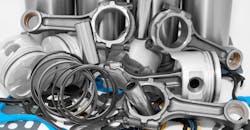White House to Ease Impact of Tariffs on Auto Parts
U.S. President Donald Trump issued an executive order on Tuesday, April 29, to reduce the scope of tariffs on imported automotive parts, aiming to lessen the growing concern in that industrial sector about the negative effects of tariffs on businesses and consumers. A 25% tariff is scheduled to take effect May 3, the prospect of which has prompted some increasingly vocal opposition from the domestic industry.
Domestic automakers, their suppliers, and dealer networks have lobbied for a reprieve, warning that the additional charges on auto parts would raise vehicle prices and reduce sales.
The executive order will address the cumulative tariff costs on vehicles by granting credit for tariffs assigned to imported steel and aluminum used in auto production. In addition, automakers that assemble vehicles in the U.S. will be eligible to receive a 15% rebate of tariff costs this year, and 10% in 2026, giving the manufacturers more time to reshore production or sourcing of parts.
U.S. Treasury Secretary Scott Bessent explained that the White House continues to pursue its goal of creating more domestic manufacturing jobs, while the President indicated the policy adjustment is intended to ease the industry’s progress toward that goal.
“We just wanted to help them (the automakers) during this little transition, short term," Trump said to a media gathering. "We didn’t want to penalize them.”
General Motors CEO Mary Barra – whose company previously rescinded its 2025 outlook on the basis of its uncertainty over the pending tariffs – acknowledged the change in U.S. trade policy.
“We believe the President’s leadership is helping level the playing field for companies like GM and allowing us to invest even more in the U.S. economy," according to Barra, in a statement.
Ford Motor Co. president and CEO Jim Farley and Stellantis chairman John Elkann made similar acknowledgements of the change.
